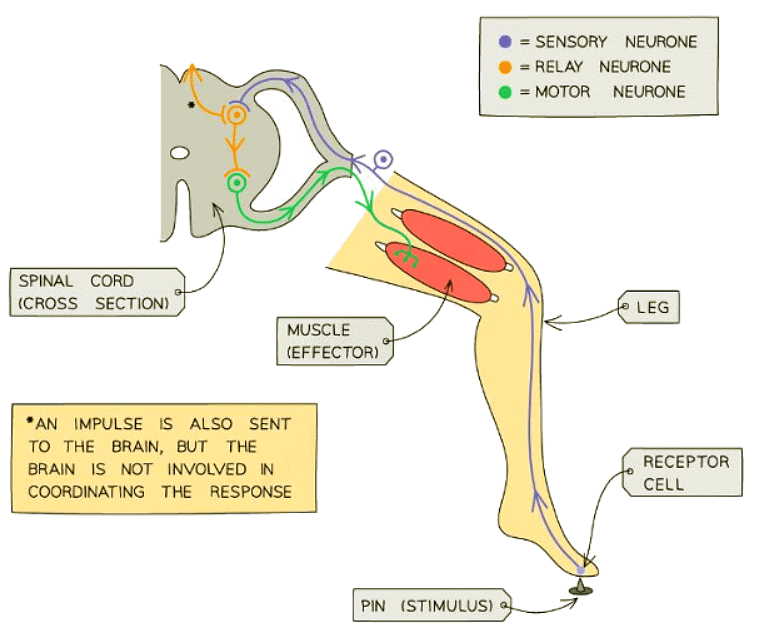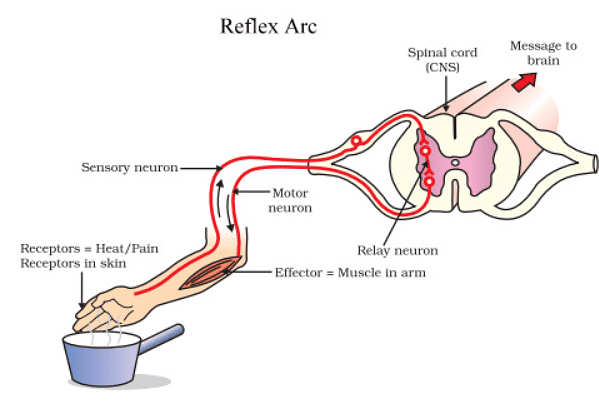Class 10 Exam > Class 10 Notes > Biology for GCSE/IGCSE > The Reflex Arc
The Reflex Arc | Biology for GCSE/IGCSE - Class 10 PDF Download
Voluntary Responses
- A voluntary response is initiated by a conscious decision made by the individual, beginning in the brain.
- For instance, reaching out to pick up a cup of coffee is a voluntary action.
- In contrast, involuntary (or reflex) responses do not require brain involvement as the coordinator. Individuals are often unaware of completing such actions until after the fact.
- Involuntary actions, crucial for survival, are rapid, while voluntary responses, requiring contemplation of consequences, take longer to execute.
Reflex Responses
- An involuntary, or reflex, response doesn't require the brain to coordinate the reaction, and you're often unaware of it until after it's happened.
- It's a rapid and automatic reaction to a stimulus, like touching something sharp or hot.
- Because it doesn't involve the brain, reflex responses are faster than other nervous responses.
- This speed helps to minimize potential damage to the body.
A reflex

A Reflex: Overview
- The stimulus, like a pin, is detected by receptors in the skin.
- Sensory neurons carry signals to the spinal cord, acting as the coordinator.
- Electrical impulses are transmitted to relay neurons within the spinal cord.
- The relay neuron then connects to motor neurons to pass on the impulse.
- Motor neurons deliver the impulse to muscles, the effectors.
- The muscle responds by contracting, moving the foot away from the object.
Example: Knee Jerk Reflex
- When a doctor taps your knee with a hammer, sensory receptors detect the tap.
- Signals travel to your spinal cord, bypassing conscious brain processing for quick action.
- The spinal cord immediately signals back, causing your leg to kick involuntarily.
The Reflex Pathway

Synapses
- Neuronal Junctions: Neurons connect at specialized points known as synapses, facilitating communication between them.
- Significance of Synapses: Synapses play a crucial role in the nervous system, forming a network that enables the transmission of nerve impulses.
- Guidance System: Similar to railway points directing trains, synapses guide nerve impulses to their intended destinations, such as specific areas in the brain.
Question for The Reflex ArcTry yourself: Which type of response requires brain involvement and conscious decision-making?View Solution
The document The Reflex Arc | Biology for GCSE/IGCSE - Class 10 is a part of the Class 10 Course Biology for GCSE/IGCSE.
All you need of Class 10 at this link: Class 10
|
101 videos|193 docs|33 tests
|
FAQs on The Reflex Arc - Biology for GCSE/IGCSE - Class 10
| 1. How does the reflex arc work? |  |
Ans. The reflex arc is a neural pathway that controls involuntary reflex responses. It involves a sensory receptor, sensory neuron, interneuron, motor neuron, and effector muscle or gland. When a stimulus is detected by the sensory receptor, the sensory neuron sends a signal to the spinal cord where the interneuron processes the information and sends a signal to the motor neuron. The motor neuron then sends a signal to the effector, causing a reflex action without the involvement of the brain.
| 2. What is the purpose of the reflex arc? |  |
Ans. The reflex arc allows for rapid, involuntary responses to stimuli in order to protect the body from harm. It bypasses the brain to save time, ensuring that the body can quickly react to potential dangers such as touching a hot surface or withdrawing from a painful stimulus.
| 3. How do neuronal synapses play a role in the reflex arc? |  |
Ans. Neuronal synapses are the junctions between neurons where neurotransmitters are released to transmit signals. In the reflex arc, synaptic transmission occurs at the synapse between neurons, allowing for the relay of information from the sensory receptor to the effector muscle or gland. This process ensures that the signal is transmitted quickly and efficiently along the neural pathway.
| 4. What are some examples of reflex actions controlled by the reflex arc? |  |
Ans. Examples of reflex actions controlled by the reflex arc include the knee-jerk reflex, where tapping the patellar tendon causes the leg to kick out involuntarily, and the withdrawal reflex, where touching a hot surface causes the hand to quickly retract to prevent injury.
| 5. How does the reflex arc differ from voluntary responses controlled by the brain? |  |
Ans. The reflex arc is an automatic, involuntary response that does not involve conscious thought or decision-making. In contrast, voluntary responses controlled by the brain require processing of information and decision-making before a response is initiated. The reflex arc allows for quick, instinctive reactions to stimuli, while voluntary responses are more complex and can be influenced by cognitive processes.
Related Searches




















